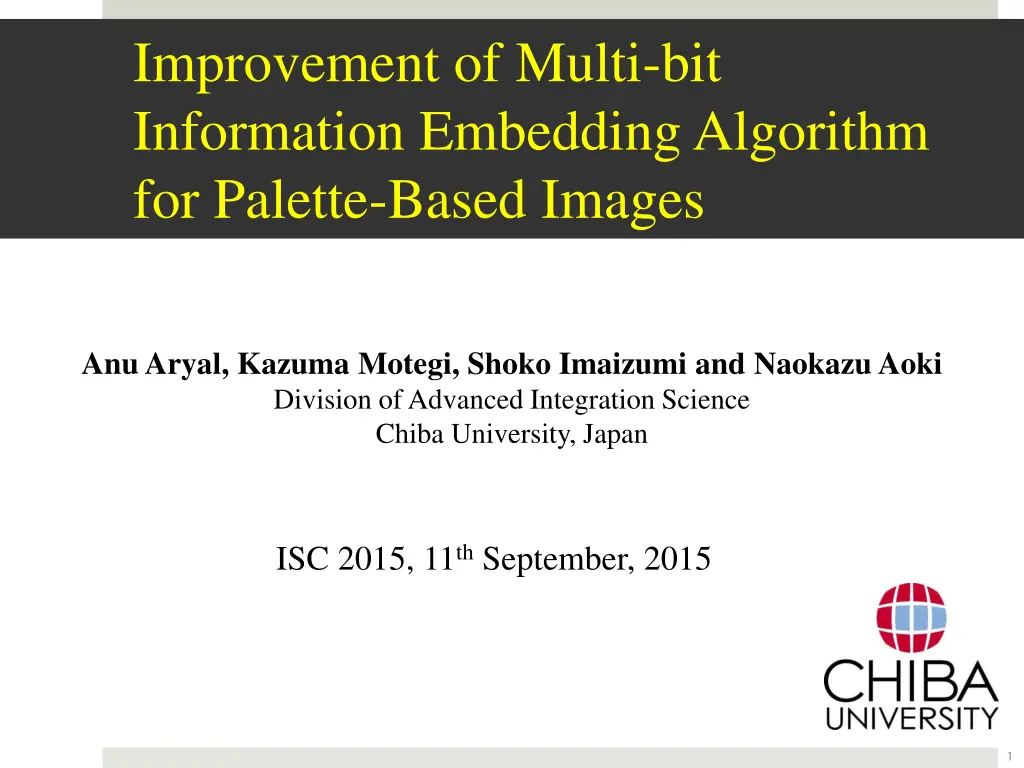
Improved Algorithm for Palette-Based Image Information Embedding
Explore the enhanced multi-bit information embedding algorithm for palette-based images developed by Anu Aryal, Kazuma Motegi, Shoko Imaizumi, and Naokazu Aoki at Chiba University, Japan. The algorithm aims to increase the embedding capacity while minimizing image degradation, addressing drawbacks of conventional methods. Discover the motivation, conventional method details, drawbacks, and the drive for high-capacity embedding in this research presented at ISC 2015.
Download Presentation

Please find below an Image/Link to download the presentation.
The content on the website is provided AS IS for your information and personal use only. It may not be sold, licensed, or shared on other websites without obtaining consent from the author. If you encounter any issues during the download, it is possible that the publisher has removed the file from their server.
You are allowed to download the files provided on this website for personal or commercial use, subject to the condition that they are used lawfully. All files are the property of their respective owners.
The content on the website is provided AS IS for your information and personal use only. It may not be sold, licensed, or shared on other websites without obtaining consent from the author.
E N D
Presentation Transcript
Improvement of Multi-bit Information Embedding Algorithm for Palette-Based Images AnuAryal, Kazuma Motegi, Shoko Imaizumi and NaokazuAoki Division of Advanced Integration Science Chiba University, Japan ISC 2015, 11thSeptember, 2015 1
Outline 2
Outline 3
Introduction Steganography [1] is the art and science of hiding information by embedding it in some other data. Unauthorized recipients unaware about the existence of embedded data. [1] Kahn, D.: The history of steganography. In: Goos, G., Hartmanis, J. (eds.) The First International Workshop on Information Hiding. LNCS, vol.1174, pp.1-5, Springer, Heidelberg (1996). 4
Conventional method [2] Embeds each k-bits message into pixels of 2 2 pixel matrix as shown in Fig. 1. Based on embedding a message into the pixels by assigning a parity to each pixel matrix according to the Euclidean distance. Fig. 1. Embedded unit of Conventional Method [2]. [2] Imaizumi, S., Ozawa, K.: Palette-Based Image Steganography for High-Capacity Embedding. Bull. Soc. Photogr. Imag. Japan, Vol.25, No. 1, pp.7-11 (2015). 5
Conventional method [2] contd. Drawbacks At maximum, only 3/4 bit per pixel can be embedded. Maximum embedded amount is smaller than those methods that embed one bit message into one pixel [3-6]. Tendency to occur large color difference that leads to image degradation. [2] Imaizumi, S., Ozawa, K.: Palette-Based Image Steganography for High-Capacity Embedding. Bull. Soc. Photogr. Imag. Japan, Vol.25, No. 1, pp.7-11 (2015). [3] Tzeng, C.-H., Yang, Z.-F., Tsai, W.-H.: Adaptive data hiding in palette images by color ordering and mapping with security protection. IEEE Trans. Commun. 52(5), 791-800 (2004). [4] Fridrich, J.: A new steganographic method for palette-based image. In: Proc. Of IS&T PICS, pp.285-289 (1999). [5] Huy, P.T., Thanh, N.H., Thang, T.M., Dat, N.T.: On fastest optimal parity assignments in palette images. In: Intelligent Information and Database Systems,vol. 7197, pp. 234-244 (2012). [6] Inoue, K., Hotta, S., Takeichi, Y., Urahama, K.: A Steganographic Method for Palette-Based Images [in Japanese]. In: The Transactions of the Institute of Electronics, Information and Communication Engineers. A, vol. 82, no.11, pp.1750-1751 (1999) 6
Motivation High capacity of embedding. Suppression of degradation of image quality. Conventional method [2] has space to improve both. [2] Imaizumi, S., Ozawa, K.: Palette-Based Image Steganography for High-Capacity Embedding. Bull. Soc. Photogr. Imag. Japan, Vol.25, No. 1, pp.7-11 (2015). 7
Outline 8
Current Research Concept Embed each k bit message into 1 3 pixel matrix as shown in Fig. 2. Embed message into a limited color by controlling the index values. Fig. 2. Embedded unit of proposed method (k = 3). 9
Proposed Method (1) 1) Sorting the color palette. 1) Embedding of message. 10
Proposed Method (2) 1. Sorting color palette using CIEDE2000 [7]. Find the darkest color in entries Ci. Set the increment j = j +1. Calculate E00between initial entries Ciand entries C j- 1. Indices are assigned to all the entries. [7] Colorimetry - Part 6: CIEDE2000 Colour-difference formula. ISO/CIE 11664-6 (2014). 11
Proposed Method (3) 2. Embedding of message. Select 1 3 pixel matrix from the target image (message length is k = 3 bits) as shown in Fig. 2. Fig. 2. Embedded unit of proposed method (k = 3). 12
Proposed Method (4) Fig. 2. Embedded unit of proposed method (k = 3). Calculate parity Snas Sn= d0(n)+ dl(n)mod 4, where dl(n)indicates the index of pixel tl(n). 13
Proposed Method (5) Table 1. Example of Pn,Snand embedded information wn. Embedding Information wn 7 6 5 4 3 2 1 0 Pn Sn 0 0 0 0 1 1 1 1 3 2 1 0 0 1 2 3 Fig. 2. Embedded unit of proposed method (k = 3). The value of Sncan be controlled by changing the indices of p(n), t0(n)and t1(n)by +1 or -1. 14
Proposed Method (6) Table 1. Example of Pn,Snand embedded information wn. Pn 0 0 0 0 1 1 1 1 Sn 3 2 1 0 0 1 2 3 Embedding Information wn 7 6 5 4 3 2 1 0 pn Index of p(n) = Even t0(n) t1(n) Index of p(n) = Odd Target matrix Difference between Sn Difference between Sn before and after before and after Difference between Sn Index of p(n) Index of t0(n)and t1(n) Index of t0(n)or t1(n) Index of t0(n)or t1(n) E00 E00 E00 Value of Pnbefore and after embedding before and after embedding embedding embedding 0 Not changed Different 2 1 Change by +1 or -1 Change by +1 or -1 Change by +1 or -1 Smaller Smaller Smallest 15
Proposed Method (7) Performs embedding process only when all E00values for the pixels of matrix become 5.0 or less else not. Steps are repeated until all the messages are embedded. Embedded message wncan be extracted after calculating Pnand Sn. 16
Proposed Method (8) Each block has been generated by delimiting colors when E00 > 5.0. Fig. 3. Color blocks and isolated colors. 17
Proposed Method (9) Maximum amount of embedded bits. Minimum amount of embedded bits. Proposed Method Proposed Method Conventional Method [2] Conventional Method [2] Fig. 4. Matrix arrangement for maximum amount of embedded bits. Fig. 5. Matrix arrangement for minimum amount of embedded bits. [2] Imaizumi, S., Ozawa, K.: Palette-Based Image Steganography for High-Capacity Embedding. Bull. Soc. Photogr. Imag. Japan, Vol.25, No. 1, pp.7-11 (2015). 18
Outline 19
Experimental Setups Amount of embedded bits: 10,800 and 21,600 bits. Used images: 256 256 pixels, 8-bit color bitmap images. Number of images: 12 Image quality metrics: PSNR and SSIM. 20
Structural Similarity (SSIM) [8] SSIM is introduced to measure the quality of distored images. SSIM has Luminance Comparison l(x,y), Contrast comparison c(x,y) and Structure comparsion s(x, y). Therefore, Fig. 6 Diagram of SSIM measurement system. [8] Wang, Z., Bovik, A.C., Sheikh, H.R., Simoncelli, E.P.: Image quality assessment: From error visibility to structural similarity. In: IEEE Trans. on Image Processing.13 (4), pp.600-612 (2004) 21
Simulation Result (I) Proposed method (10,800 bits) SSIM = 0.871 PSNR = 40.34 Original (Pepper) Conventional method (10,800 bits) SSIM = 0.831 PSNR = 36.58 22
Simulation Result (I) Proposed method (21,600 bits) SSIM = 0.754 PSNR = 37.19 Original (Pepper) Conventional method (21,600 bits) SSIM = 0.699 PSNR = 33.67 23
Simulation Result (III) Proposed method (10,800 bits) SSIM = 0.867 PSNR = 43.49 Original (Balloon) Conventional method (10,800 bits) SSIM = 0.822 PSNR = 40.73 24
Simulation Result (IV) Proposed method (21,600 bits) SSIM = 0.751 PSNR = 40.62 Original (Balloon) Conventional method (21,600 bits) SSIM = 0.674 PSNR = 37.68 25
Quantitative Evaluation (I) 21,600 bits 10,800 bits Fig. 7. Evaluation using PSNR. 26
Quantitative Evaluation (II) 21,600 bits 10,800 bits Fig. 8. Evaluation using SSIM. 27
Quantitative Evaluation (III) Table 2. Maximum and minimum values of embedded bits. . Embedded bits Proposed Method Conventional method [2] Maximum bits 65, 280 49,152 Minimum bits 39,168 21,675 [2] Imaizumi, S., Ozawa, K.: Palette-Based Image Steganography for High-Capacity Embedding. Bull. Soc. Photogr. Imag. Japan, Vol.25, No. 1, pp.7-11 (2015). 28
Outline 29
Conclusion Enhances data embedding with larger capacity. - Maximum amount of embedded bits is1.3 times and Minimum amount is 1.8 times more than conventional method. Improves the image quality by suppressing image quality degradation. 30
Thank you 31


